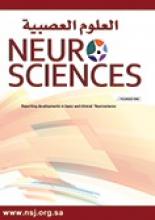Research ArticleOriginal Article
Open Access
Length of MRI signal may predict outcome in advanced cervical spondylotic myelopathy
Amro F. Al-Habib, Ahmed M. AlAqeel, Abdulrahman S. Aldakkan, Fahad B. AlBadr and Shaffi A. Shaik
Neurosciences Journal January 2015, 20 (1) 41-47;
Amro F. Al-Habib
From the Division of Neurosurgery (Al-Habib, AlAqeel, Aldakkan), Department of Surgery, the Departments of Radiology (AlBadr), and Family and Community Medicine (Shaik), College of Medicine, King Saud University, Riyadh, Kingdom of Saudi Arabia
MD, FRCSCAhmed M. AlAqeel
From the Division of Neurosurgery (Al-Habib, AlAqeel, Aldakkan), Department of Surgery, the Departments of Radiology (AlBadr), and Family and Community Medicine (Shaik), College of Medicine, King Saud University, Riyadh, Kingdom of Saudi Arabia
MDAbdulrahman S. Aldakkan
From the Division of Neurosurgery (Al-Habib, AlAqeel, Aldakkan), Department of Surgery, the Departments of Radiology (AlBadr), and Family and Community Medicine (Shaik), College of Medicine, King Saud University, Riyadh, Kingdom of Saudi Arabia
MDFahad B. AlBadr
From the Division of Neurosurgery (Al-Habib, AlAqeel, Aldakkan), Department of Surgery, the Departments of Radiology (AlBadr), and Family and Community Medicine (Shaik), College of Medicine, King Saud University, Riyadh, Kingdom of Saudi Arabia
MDShaffi A. Shaik
From the Division of Neurosurgery (Al-Habib, AlAqeel, Aldakkan), Department of Surgery, the Departments of Radiology (AlBadr), and Family and Community Medicine (Shaik), College of Medicine, King Saud University, Riyadh, Kingdom of Saudi Arabia
PhD
References
- ↵
- Matz PG,
- Anderson PA,
- Holly LT,
- Groff MW,
- Heary RF,
- Kaiser MG,
- et al.
- Holly LT,
- Matz PG,
- Anderson PA,
- Groff MW,
- Heary RF,
- Kaiser MG,
- et al.
- ↵
- Chatley A,
- Kumar R,
- Jain VK,
- Behari S,
- Sahu RN
- ↵
- Kalsi-Ryan S,
- Karadimas SK,
- Fehlings MG
- ↵
- Baron EM,
- Young WF
- ↵
- Ahn JS,
- Lee JK,
- Kim BK
- ↵
- Scardino FB,
- Rocha LP,
- Barcelos AC,
- Rotta JM,
- Botelho RV
- ↵
- Fernandez de Rota JJ,
- Meschian S,
- Fernandez de Rota A,
- Urbano V,
- Baron M
- ↵
- Vedantam A,
- Jonathan A,
- Rajshekhar V
- ↵
- Avadhani A,
- Rajasekaran S,
- Shetty AP
- ↵
- Shin JJ,
- Jin BH,
- Kim KS,
- Cho YE,
- Cho WH
- ↵
- Mummaneni PV,
- Kaiser MG,
- Matz PG,
- Anderson PA,
- Groff M,
- Heary R,
- et al.
- ↵
- Papadopoulos CA,
- Katonis P,
- Papagelopoulos PJ,
- Karampekios S,
- Hadjipavlou AG
- ↵
- Rajshekhar V,
- Kumar GS
- ↵
- Matsunaga S,
- Sakou T,
- Taketomi E,
- Komiya S
- ↵
- Alafifi T,
- Kern R,
- Fehlings M
- ↵
- Nurick S
- ↵
- Macdonald RL,
- Fehlings MG,
- Tator CH,
- Lozano A,
- Fleming JR,
- Gentili F,
- et al.
- ↵
- Choi S,
- Lee SH,
- Lee JY,
- Choi WG,
- Choi WC,
- Choi G,
- et al.
- ↵
- Uchida K,
- Nakajima H,
- Sato R,
- Kokubo Y,
- Yayama T,
- Kobayashi S,
- et al.
- ↵
- Yamazaki T,
- Yanaka K,
- Sato H,
- Uemura K,
- Tsukada A,
- Nose T
- ↵
- Fujiwara K,
- Yonenobu K,
- Ebara S,
- Yamashita K,
- Ono K
- ↵
- Singh A,
- Choi D,
- Crockard A
- ↵
- Karpova A,
- Arun R,
- Davis AM,
- Kulkarni AV,
- Massicotte EM,
- Mikulis DJ,
- et al.
- ↵
- Yukawa Y,
- Kato F,
- Yoshihara H,
- Yanase M,
- Ito K
- ↵
- Ohshio I,
- Hatayama A,
- Kaneda K,
- Takahara M,
- Nagashima K
- ↵
- Ramanauskas WL,
- Wilner HI,
- Metes JJ,
- Lazo A,
- Kelly JK
- ↵
- Fox JL,
- Wener L,
- Drennan DC,
- Manz HJ,
- Won DJ,
- Al-Mefty O
- ↵
- Morio Y,
- Teshima R,
- Nagashima H,
- Nawata K,
- Yamasaki D,
- Nanjo Y
- ↵
- Nurick S
- Payne EE,
- Spillane JD
- ↵
- Burrows EH
- Tsurumi T,
- Goto N,
- Shibata M,
- Goto J,
- Kamiyama A
- ↵
- Chiewvit P,
- Tritrakarn SO,
- Phawjinda A,
- Chotivichit A
- ↵
- Bucciero A,
- Vizioli L,
- Tedeschi G
- Ebersold MJ,
- Pare MC,
- Quast LM
In this issue
Length of MRI signal may predict outcome in advanced cervical spondylotic myelopathy
Amro F. Al-Habib, Ahmed M. AlAqeel, Abdulrahman S. Aldakkan, Fahad B. AlBadr, Shaffi A. Shaik
Neurosciences Journal Jan 2015, 20 (1) 41-47;
Jump to section
Related Articles
- No related articles found.
Cited By...
- No citing articles found.





